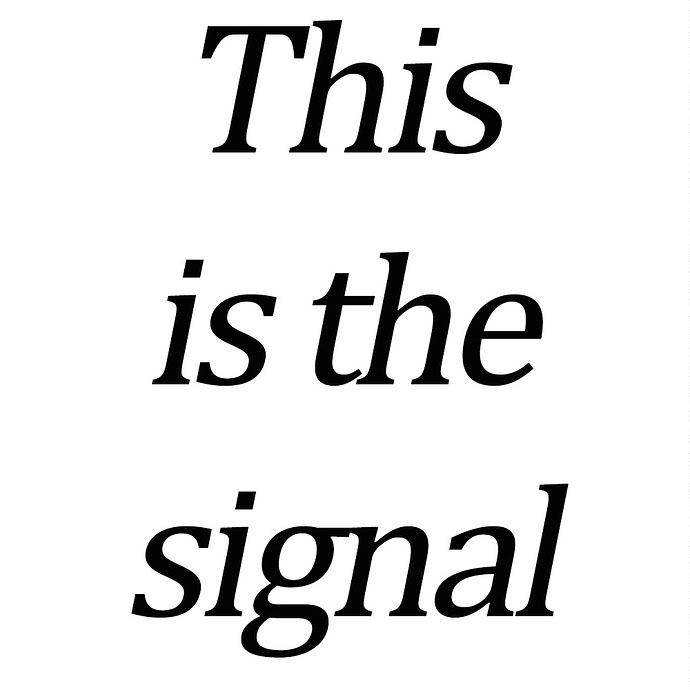That more closely depicts an analogue signal. If it were digital the right-hand image would be identical to the left. If the signal was degraded to such an extend there’d be no image on the right (the cliff effect.)
I’m just going on my first hand personal experience dealing with static electricity build-up in my listening room that would become audible during an extended winter listening session. The only way to get rid of it was to disconnect the renderer from the hi-fi chain and DAC and then touch the renderer to discharge it (and hope like hell it didn’t blow the board). A ferromagnet on the DAC side of the USB cable got rid of it.
I do not really like this analogy because the right side of the picture got a shade. On the analog side this is true but on the digital side at the end of the transport you still got the left sharp picture.
I prefer this example:
You buy a bottle of wine in a shop, drive home in your car. It is raining. You park your car in the garage, walk to your house with the bottle in a bag. The way from the garage is either sand, earth or concrete.
It is still raining. You enter the house. Go to the living room, put the bottle of wine onto the table.
The content of the bottle is not modified. It is still the same wine, as you did buy in the shop. But if you carry dirt into your living room or not depends on your behaviour.
If your way from the garage to your house is concrete, there will be almost no dirt, you carry into your house. If it is earth, it will be muddy and there is a lot of dirt carried into the house. But the wine is not modified.
Now it depends what you do when you enter the house. You change your shoes, leave the dirty shoes at the entry or walk with your dirty shoes into the living room.
If you drink your wine in the living room, you have either a clean living room, or you did carry dirt into the living room.
It does not matter what car you drive, it does not matter what house you have, but the way from the garage to your house, the weather and the behaviour when you enter the house is important. If the sun shines and it is dry, then it is not important if you change or clean your shoes when you enter the house. But it is when it is raining.
The DAC is basically when you open the bottle and put it into a glass. And now you can have different glasses, cool the wine, drink it warm. That is what your DAC is doing with filters. If you did walk with dirty shoes into the living room, the pleasure is reduced, your wife is unhappy, you don’t like the wine.
If we take lost bits or packet loss into this example, that would mean that your bottle is broken and you have no wine to carry into your living room.
Here’s my analogy: network components do not need audiophile tweaks. The only, only, only possibility is that electrical noise could leap from some network component to the analog side of a DAC.
That would mean bad design, something out of spec, just as likely to be corrected by replacing the out of spec component with another standard one. Audiophile network components are no more likely to fix that problem than standard ones. And perhaps less likely, since many of the tweaks these audiophile network pieces have take them out of spec.
Yes, there are different speeds of network gear. But there are not quality grades of accuracy or precision in SOHO network gear.
Audiophile network gear is for show. Enjoy it if you like it. No harm, no foul, until people start spreading misinformation that causes the uninitiated to spend their audio budget on peripheral bling rather than focusing on the core issues or logical problem solving first.
Your understanding is wrong, and so is your analogy. Please try again once you’ve done the legwork.
For the curious, SHA hash of image on left: 9464b517a81f0c6653f37e6e77d20f50692d27e4 , of image on right: 178458fc2876bcb25843cd6f6749f4027314c142 .
(if you’d like to try it by yourself, crop to square, save as tiff, then, if you’re using OSX, open terminal, type shasum )
That’s why you cannot reconcile “An ethernet cable transmits a bit-perfect, error-corrected, and buffered signal to a DAC. Bits at one end, the same bits at the other.” and that analogy.
Here are two files that give a more accurate visual analogy to the statement “The router and ethernet cables affect sound quality”:
If you’d like to reproduce the experiment, pick an image of your choice, make a copy of it, shasum [path to filename of original] , then shasum [path to filename of copy]. Note down any difference. If you’d like to verify the effect your ethernet cables and router have on your signal path, email the files to yourself, and shasum [path to emailed copies].
I don’t know what’s going on with you, but something is wrong. I downloaded and checked both of your pictures. Since I don’t have a Mac or Linux but a Windows computer, the Microsoft tool “File Checksum Integrity Verifier” was used. The file name is: fciv.exe, download and usage can be found HERE
I checked both of your images (file-a.jpg & file-b.jpg) here with both the MD5 and the SHA1 hash algorithms. Both images have the identical checksum.
//
// File Checksum Integrity Verifier version 2.05.
//
MD5
903494943b1ef3fbd56a387b5095366b file-a.jpg
903494943b1ef3fbd56a387b5095366b file-b.jpg
SHA-1
e7d378bfd8f726e64f14d80ddd43b0f2bf799845 file-a.jpg
e7d378bfd8f726e64f14d80ddd43b0f2bf799845 file-b.jpg
Then, as suggested by you, I created a test image in Photoshop and made a copy of it, for whatever reason.
myfile
myfilecopy
And checked both via fciv.exe. The checksums of the two images, like those of your images, are absolutely identical.
//
// File Checksum Integrity Verifier version 2.05.
//
MD5
f3f39f20ed16b47415fb9ef842093b5c myfile.jpg
f3f39f20ed16b47415fb9ef842093b5c myfilecopy.jpg
SHA-1
8802340420397e0da3ee6aa362296646d4d5246c myfile.jpg
8802340420397e0da3ee6aa362296646d4d5246c myfilecopy.jpg
Now I have sent both pictures to myself via email and checked them again. Needless to say that all checksums are identical.
//
// File Checksum Integrity Verifier version 2.05.
//
MD5
f3f39f20ed16b47415fb9ef842093b5c myfile.jpg
f3f39f20ed16b47415fb9ef842093b5c myfilecopy.jpg
f3f39f20ed16b47415fb9ef842093b5c myfile-email.jpg
f3f39f20ed16b47415fb9ef842093b5c myfilecopy-email.jpg
SHA-1
8802340420397e0da3ee6aa362296646d4d5246c myfile.jpg
8802340420397e0da3ee6aa362296646d4d5246c myfilecopy.jpg
8802340420397e0da3ee6aa362296646d4d5246c myfile-email.jpg
8802340420397e0da3ee6aa362296646d4d5246c myfilecopy-email.jpg
Conclusion:
At least in my network there seem to be no oddities. Everything is exactly as I expect it to be. For this reason, I can conclude that my Ethernet cable as well as my network transmit a bit-accurate signal.
Actually, I suspect you have misunderstood the point of my analogy. I wasn’t suggesting the images are identical - clearly they’re not. My point was that the salient part of the image - the text - is unaffected by the noise. ‘This is the signal’ is clearly the message, and equally intelligible in both cases. As such the added noise has no effect on the transmission of that message - any normal person can read both quite clearly and unambiguously.
The point of the analogy was to suggest that given the bit-perfect, error-corrected, and buffered signal that is transmitted to a DAC via an ethernet cable, that any RF noise is equally irrelevant.
So no extra legwork necessary.
Yep, I prefer your example too, but I think we’re both saying exactly the same thing. My version arose from my interest in photography. Had I thought more about my love of wine I might have gone with your version ![]()
As they should 
Please accept my apologies for being so trigger happy.
There was a nice steganography trick with encoding text into inverted noise layers in photoshop, btw - essentially, you ended up with two separate images of visually identical noise, which, when put through a difference filter, would show a message.
No problem, it’s easy to end up at cross-purposes, especially when discussing such a deeply sensitive topic as cables ![]()
And thanks for mentioning the steganography trick - that’s one I haven’t seen.
Take that audiophile switch designers.
They’re clever little cockroaches, they’ll find marketing terminology to invent and resolve flaws in no time and then there’ll be $5k switches for the really discerning audiophool.
I taken on a whole community’s rage for expressing the bs that it is when it comes to networking and audiophilia. The whole thread has been fun. more fun has been the million dislikes I was able to acquire in less than a day.
LOL
There is a limit to some of the BS that we as audiophiles can buy on. Some I buy just because the wow and cool factor… nothing more or less.
I join you. I think it is time to speak up and not just give up and leave the world to the “snake oilers”.
Ethernet worlds for years, worldwide in any industry. It is THE reliable transport for data. But when it comes to audiophile connectivity something is bad, you need special cables. A little bit funny, that no one else has these problems.
I’m sure it’s not about the bits…no arguments if it works it works…its the switching noise this kind of device exhibits that impacts on the environment and devices around and connected to it. Says he with 5 switches in one room plus an ER  (shoot me now - I was intrigued). I’m also a communications and networking specialist for over 40 years.
(shoot me now - I was intrigued). I’m also a communications and networking specialist for over 40 years.
No we don’t shoot you. You just must listen 5 hours of music you hate on a horrible HiFi system!
I agree, the problem is the electrical noise, which on may DACs is not filtered properly. But I think we should ignore these products and call them by Naim, sorry, name.I have also no problem if somebody uses filter tools in front of the DAC to improve these things, but again they exist for all other industries at a reasonable price. I only have a problem if somebody tries to sell me a criminal expensive pieces of whatever to fix a problem, which with clean design would not exist and invent a story around it.
sadly most of the consumer level switches and routers too for that matter are built to such a low price point that emitted interference is not a priority to reduce, even the power supplies are cheap as chips MIC SMPS for a $ a pop.
Most home systems perhaps dont have the chops to pick up some of this noise, and people dont hear it also as the systems can’t produce it well enough to be a concern.
I’m suffering electrical noise now in the 5.333KHz region and trying to track it down but its seems to be riding the mains wiring as far as I have been able to tell.
Once you’ve located the source and resolved the issue the noise will be gone. Would a $1,000 Ethernet cable resolve the matter? Has this unwanted noise affected bass, soundstage and so on?
I use good cable, I don’t subscribe to the money no object cables for anything. I make most of my own power and audio cables…for Ethernet I buy from FS.com mostly now. Have some fibre also in the network. I can pick this noise up easily at the mains breaker and incoming power board so I’m pretty sure its riding the mains…question is - is it something injected from inside or outside the house.
This is a real-world example of noise interference. Unwanted noise within the range of human hearing can be audible but it doesn’t change the presentation of the recorded music … as you say elsewhere turn up the volume and it’s gone.

